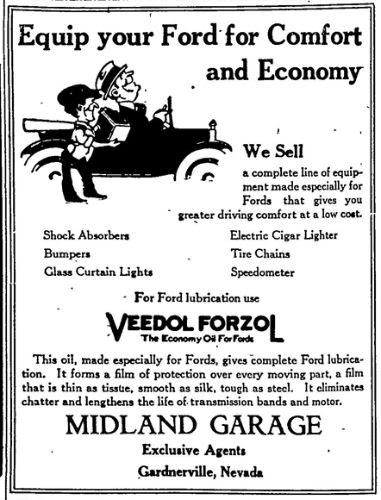It was 1883 when young John Arendt Jensen left his native Denmark to come to America in 1883. Just 24 years old, Jensen was full of energy – and dreams.
Arendt Jensen didn’t wait long to take a spouse; he married Pauline (Lena) Norgaard (also from Denmark) that same September in Eureka, California. Though the couple remained for a while in Humboldt County, before long they were off on a new adventure.
Lena was a sister of Anna Harris, who (with her husband) was operating a store in Genoa. So no doubt the Jensens had already heard stories about the bustling Carson Valley. In the summer of 1887, Arendt and Pauline arrived in Genoa.

Jensen wasted no time opening his own store — in the new, up-and-coming town of Gardnerville. He purchased an acre of land there less than three weeks after arriving. And by that December, Jensen was purchasing goods in San Francisco to stock his new store — the first retail store in Gardnerville.
The Jensen store was centrally located on Gardnerville’s Main Street, not far from the town’s namesake hotel. But the small settlement was still sparsely populated. Jensen’s store was said to be “flanked by sagebrush and barbed wire fences.” His home and business were one and the same; the store was in front, while living quarters for his family were in the rear.
By December, 1889, after two years in business, Jensen had already “built up a good trade.” He was said to be well-liked by locals, and “strictly honest in all his dealings.” A year later, the newspaper described his store as “thriving,” noting that Jensen had just expanded the store/living quarters with a 34’ x 36’ addition.
Not all was sweetness and light in the life of the merchant, however. In February, 1891, Jensen got mugged while visiting Carson City on business. A pair of thieves struck Jensen on the head with a sandbag, rendering him unconscious. Jensen came home minus a few buttons on his vest. But luckily the canny merchant hadn’t lost the $1,000 he’d just collected; he had taken the precaution of putting his cash in a safe just before the robbery occurred.
Jensen’s retail business continued to thrive, and soon outgrew its original small quarters. In the spring of 1896, Jensen built a new store just south of his original building. Locals will fondly remember this new store in its later incarnation as the Midland Garage.

By 1900, Jensen apparently figured the life of a landlord would be simpler than that of a merchant. He sold his stock of merchandise and leased his store and warehouse to C.H. Eaton. Jensen was eager to move on to another business endeavor: banking. In January, 1900, with $25,000 in capital, Jensen opened the Douglas County Bank. Ads proudly list Jensen as the bank’s owner.

Jensen continued to make improvements to assist Eaton with the store, adding a 26’ x 50’ warehouse with corrugated metal exterior south of the store. Eaton seemed to prosper for a time, and in February, 1900, married Annie Frey.


But Eaton apparently didn’t have the same stomach for retail business as Jensen; in January 1905, he threw in the towel and closed the store.
By May the tireless Jensen was back in charge again, selling groceries and hardware. He also built a “large brick cellar” that September – a building that (as we’ll see in a minute) is happily still there.
And Jensen was hardly done making improvements. In August, 1906, he broke ground for a new 50 x 100-foot brick building just down the street. This was originally described as a “warehouse,” but soon would become his new store – complete with a freight elevator in the rear!

As for Jensen’s older store just up the street – well, buggies were on the way out. With automobile traffic increasing, the Midland Garage took over the building in early 1920 and by December, 1921, had become a “success.”
At the Midland, travelers could find not only a good mechanic for auto repairs but also accessories like tires and those all-important inner tubes. Electric cigar lighters could also be purchased there. The Midland even offered parking for auto camping in the rear. Oddly enough, a plumbing business was also attached to the garage.

The Midland Garage would be a Gardnerville fixture for almost a century. In 2007, its façade got a fresh paint upgrade when the building became home to Yager’s small engine repair.
But time took its sad toll on the 1896 structure. The same inexorable force that had prompted its birth eventually led to its demise: simple economics. The decaying building would have cost too much to repair. The Midland Garage was finally torn down in October 2019. And with it went Jensen’s 1896 store.

Not everything from Arendt Jensen’s time is gone, however. Remember that brick storage cellar he built in 1905? Happily, that sturdy structure was saved.
It’s one small but important reminder of Arendt Jensen, an unsung hero who helped build early Gardnerville. And our next story will share the backstory of another building Jensen built – today’s Cheshire Antiques!

And now, can you possibly help solve a “history mystery”?? We’ve tried, but haven’t been able to locate a photo of Arendt Jensen. If you or someone you know has a picture of this early Gardnerville pioneer, we’d love to see it!
_________________
*Grateful thanks to Michael Fischer for sharing extensive historical information for this story, and especially for helping sort out confusion with Jensen’s various store locations. Any errors that may have crept in are, of course, strictly my own.
*Cover photo of the Midland building when it was Yager’s Small Engine Repair by Rich Jensen, Flickr, Creative Commons.
